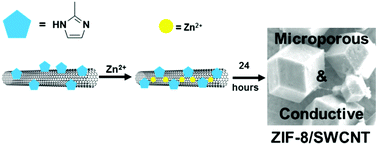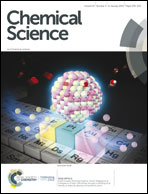Growth of ZIF-8 on molecularly ordered 2-methylimidazole/single-walled carbon nanotubes to form highly porous, electrically conductive composites†
Abstract
The combination of porosity and electrical conductivity in a single nanomaterial is important for a variety of applications. In this work, we demonstrate the growth of ZIF-8 on the surface of single-walled carbon nanotubes (SWCNTs). The growth mechanism was investigated and a molecularly ordered imidazole solvation layer was found to disperse SWCNTs and promote crystal growth on the sidewalls. The resultant ZIF-8/SWCNT composite demonstrates high microporosity and electrical conductivity. The ZIF-8/SWCNT composite displayed semiconducting electrical behavior and an increase in sensor sensitivity toward ethanol vapors versus pristine SWCNTs.



 Please wait while we load your content...
Please wait while we load your content...